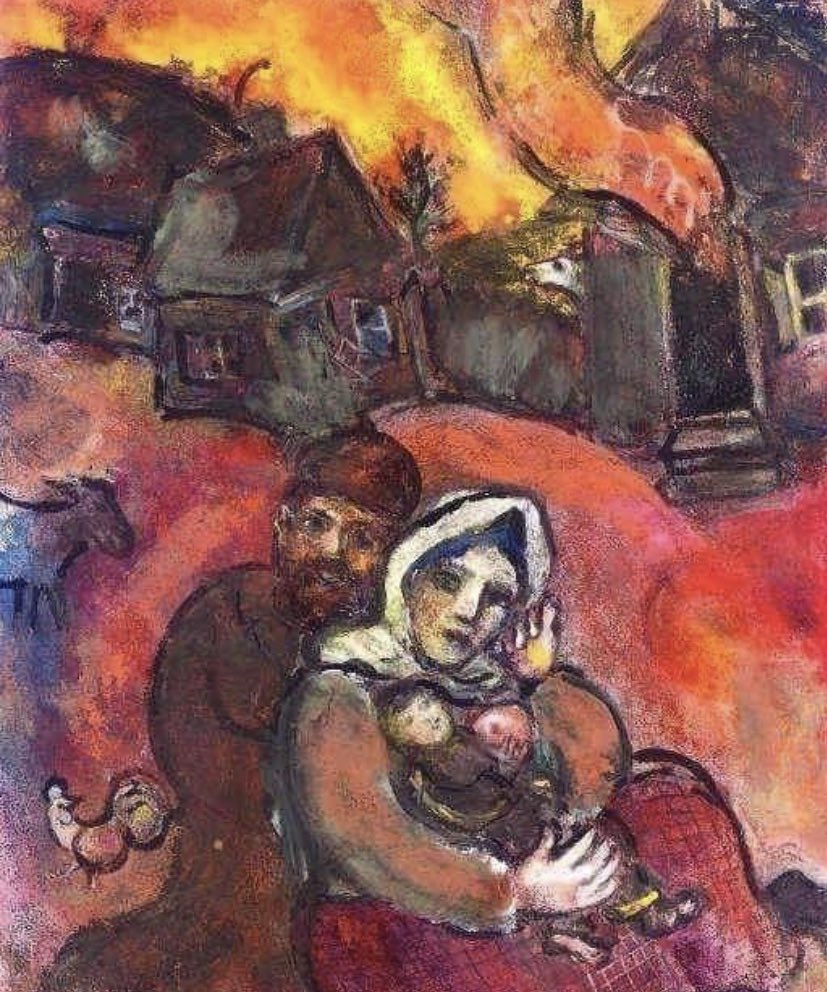
March 19, 2020
When you think of the work of the Russian-French painter Marc Chagall, the first thing that probably comes to mind are his dreamlike or biblical themes or his stained glass windows which bathe some of the world’s church buildings in such a truly wonderful light.
When you think of the work of the Russian-French painter Marc Chagall, the first thing that probably comes to mind are his dreamlike or biblical themes or his stained glass windows which bathe some of the world’s church buildings in such a truly wonderful light.
They are pictures that love colour. Some powerful, others delicate. For the most part they seem to come from another world where imagination holds sway and gravity plays no role. Dancing or free-floating figures like this white dressed flower-adorned woman against a heavenly light blue background are familiar to anybody who has ever been interested in painting.
But there are also quite different pictures. The other day I recalled one of these images. It’s been a very long time since first I saw it but it moved me so much at first sight that I have never forgotten it.
In my first encounter with this painting the strong effect it had on my thoughts and feelings was enough for me. Only yesterday it unexpectedly resurfaced in my memory. I began to look for it in the internet. And when I finally found it and read its title, I couldn’t and wouldn’t leave it at the mere effect it had on me as I had once done but began to research the possible background to its creation. Because I found out that Chagall had painted this picture sometime between 1940 and 1943 and had given it the title “La famille Ukrainienne”.
The Ukrainian family portrayed by Chagall in this painting in the early 1940s was fleeing war and destruction. And so I began, for the first time in my life to read a little more about the history of Ukraine, and would recommend anybody who now wonders about the resilience of this people under the invasion of Russian forces or anyone who might even be inclined to think that they should give up the fight for their independence and freedom, to do the same.
When Chagall painted this picture Stalin‘s “Great Terror” had already struck Ukraine a few years before. Several million Ukrainians were deported to the Gulag, at least 500,000 of them lost their lives. And after Hitler broke the non-aggression pact with Stalin and started the war with the Soviet Union, Ukraine became one of the main theatres of the Second World War in the 1940s. Once more, immeasurable suffering came upon the country. Historical research estimates that up to 7.7 million people, more than one fifth of the population of the country, perished at that time.
And while I am sitting at home at my desk, reading up about a painting by Chagall and the history of Ukraine on the internet, for more than the past three weeks Russian forces acting on the order of their president have been conducting a brutal war of aggression against Ukraine which has at long last been independent, free and sovereign for over 30 years. I don’t need such knowledge of history to find my own position and stance. But such knowledge does help me better understand what is becoming impressively obvious to the whole world these days: that the people of Ukraine will not willingly surrender the precious commodity of their freedom for any price in the world. No, I must correct myself. I think I understand it. But true understanding can probably only be with those who carry this history within them, who carry Ukraine within them and are now fighting for its independence.
I carry another history in me. I am well aware of it and of the responsibility it entails for the present. After plunging the world into a war of unprecedented magnitude, the Germans were given, on their unconditional surrender, what Ukrainians are fighting for today – freedom, democracy and, after reunification, even sovereignty. For this very reason I would like to see more respect shown to a president of Ukraine who – like Mannerheim once did in Finland – personally stands up to Russia’s attempt to annex the country. The fact that a German Chancellor remained mute after the speech by this strong Ukrainian President to the German Bundestag is something that almost robbed me of language.
The memory of a painting by Marc Chagall today has liberated me from such speechlessness.
That art and history would combine in my mind with the closeness of a real present-day war in Europe could not be expected and has overwhelmed me. A short while ago, I was planning to present a huge exhibition of OUBEY’s art in April in Moscow together with wonderful people and partners there. I cancelled this exhibition on the 25th February of this year. I didn’t know anything about the history of Ukraine at that time. But I had seen and heard Putin’s declaration of war on television. Anyone who had heard, seen and understood that knew everything one needed to know to make this decision. And in this attitude I agree with OUBEY to this day.
Only, of course, Chagall didn’t paint this work of art in the past 6 weeks, since the Russians invaded Ukraine and started unleashing such devastation, brutality, and death. He painted it sometime between 1940 and 1943, when Ukrainians were fleeing the war and destruction brought about by another Russian, Stalin’s “Great Terror”. It is uncanny – and heartbreaking – to realize that this scene could just as easily be depicting what is going on right now, 80 years…
Here’s a link to some well-structured , compact information on the history of Ukraine.
